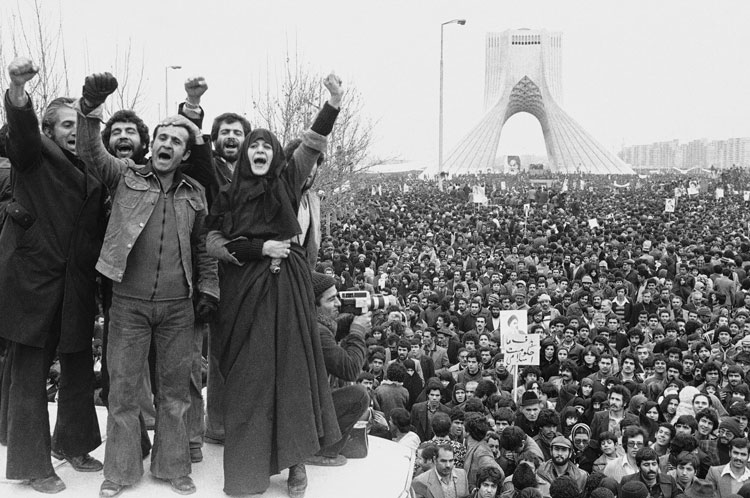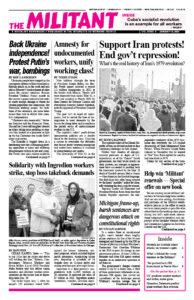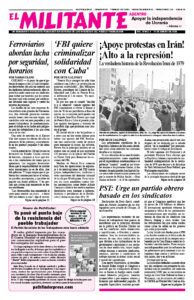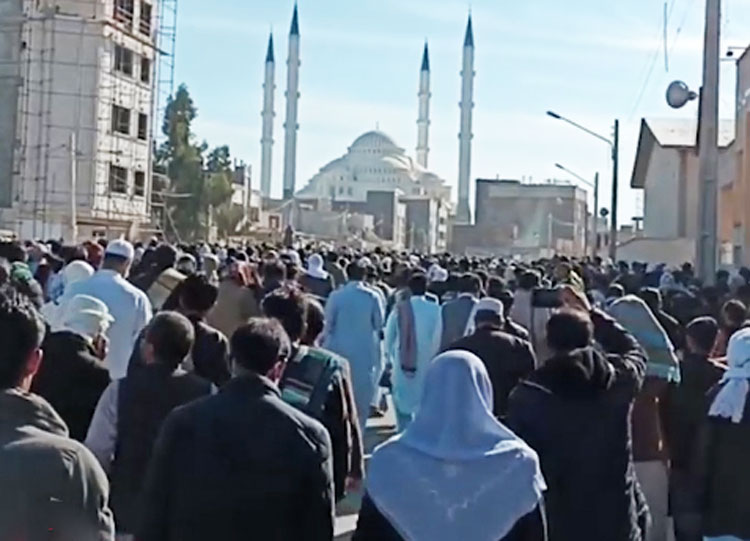The capitalist rulers of the Islamic Republic of Iran are divided on how to face continuing challenges to their regime.
Neither their slanders of anti-government protesters as dupes of U.S. imperialism, or of the “Zionist” Israeli government, nor their brutal attacks on daily protests, nor attempts at appeasement have succeeded in pushing back the movement sparked by the Sept. 16 death of Kurdish woman Mahsa Amini — Gina Amini in the Kurdish language. She died three days after being arrested by the hated “morality” police for allegedly violating the dress code for women.
Supreme Leader Ali Khamenei and President Ebrahim Raisi claim that their Islamic Republic represents the anti-imperialist continuity of the 1979 revolution that overthrew the U.S.-backed dictatorship of Shah Mohammad Reza Pahlavi. When President Joseph Biden claimed in November that he wanted to “free” Iran, Raisi replied the country had been freed in 1979.
Claims by any section of the bourgeois-clerical hierarchy that it represents the 1979 revolution is a lie. It was a deepgoing, modern, popular revolution, not a religious jihad. Millions of people took to the streets despite fierce repression by the shah. Striking oil workers played a decisive role in the final battles that brought down that dictatorship.
After forcing out the shah, workers took the lead in setting up shoras — councils — in factories and neighborhoods to fight for workers control over production and job conditions. Farmers fought for land. Oppressed nationalities, including Kurds, Arabs, Baluchs and others, fought for the right to speak their own languages and against discrimination in jobs, education and housing.
When Ayatollah Ruhollah Khomeini — popular for past opposition to the shah — tried to make the hijab mandatory for female government workers in 1979, tens of thousands took to the streets, standing up to the new regime’s thugs and forcing the government to back off.

In 1980 Iraqi dictator Saddam Hussein invaded Iran with U.S. backing, hoping to overthrow the revolution. Thousands of Iranian toilers volunteered for the military to defeat the invasion.
Khomeini and his supporters in the capitalist class took advantage of the war to use the newly formed Islamic Revolutionary Guard Corps and its Basij paramilitary force as battering rams against workers and their vanguard, taking aim against gains made in the revolution. By mid-1983, a counterrevolution was consolidated, which included imposing the hijab. Workers and farmers were pushed back, but not crushed.
When the bourgeois-clerical regime’s officials say they represent the revolution, it’s the counterrevolution that they are looking to.
Today’s protests also stand on mass anti-government actions that exploded in 2018 and 2019, showing the depth of working people’s anger toward the regime, including its military adventures abroad. These actions are unfolding amid a deep economic crisis, worsened by U.S.-backed sanctions against Iran.
Farhiktegan, a conservative daily, recently reported that “the number of marriages and births has been decreasing” and “illegal abortions” have risen, as young people face increasing difficulties starting and providing for a family.
The Union of Truckers and Drivers posted videos of lines of vehicles at gas stations Dec. 27 because of a fuel shortage. “Is this the right of the people of Iran? To wait in these long lines for the natural resources of their country,” the union wrote. “Were you able to manage this by executing the protesters?” referring to the two people hanged by the regime earlier in the month.
Divisions widen
One example of the divisions caused by more than three months of protests has been statements by prominent Sunni cleric Maulana Abdul-Hamid, based in Zahedan, capital of Sistan-Baluchistan province. One of the most underdeveloped regions and home to the mostly Sunni Baluch nationality, Baluchistan has been a hotbed of opposition to the regime.
“The Iranian people want nothing but justice and freedom. In 1979, the people of Iran made a revolution for these things,” Abdul-Hamid told tens of thousands of people at a Dec. 30 prayer service. “There should be no difference in rights between men and women.”
While Abdul-Hamid has criticized some of the regime’s actions, he was a key backer of Raisi’s victory in the June 2021 presidential election. Government supporters have harshly criticized him for speaking out against the death penalty and for freeing political prisoners.
A new bloc of opponents of the Islamic Republic based outside Iran issued a joint New Year’s statement for “freedom and justice.” This includes the shah’s son, Reza Pahlavi; journalist Masih Alinejad, a well-known opponent of imposing the hijab; and Hamed Esmaeilion, a leader of families of the victims of the downing of Ukrainian Flight 752 who has spearheaded protests around the world.
This coalition, which pretties up the bloody reign of the shah by linking it to today’s protests, seeks recognition from Washington and other imperialist powers as a “democratic” alternative to the current regime. But this is the opposite of what is needed to advance the fight of workers and farmers of Iran to defend their own interests.
Widening divisions in capitalist class
Another example of widening divisions in the capitalist class was when Brig. Gen. Hamid Abazari spoke at an event in Mazandaran province honoring Basij thugs and other agents of the Guard who have died in clashes with protesters over the last few months. The longtime Guard leader denounced unnamed “high-ranking” corps officers who he said were not supporting the government’s crackdown.
Then the Guard Corps issued a statement saying that his comments “were his own personal opinion, which does not correspond to the facts.”
So far, the division in the Guard Corps has not prevented the regime from stepping up its repression in the Kurdish regions of the country. Kurds have long been denied political and cultural rights. Islamic Guard forces and Basij thugs clashed with demonstrators and occupied the Kurdish town of Javanrud Dec. 31 in an attempt to block a commemoration for those killed in earlier protests.
Meanwhile, strikes by workers fighting for wage hikes to keep up with inflation and better conditions continue.
The arrest of more than a dozen striking oil workers in Asaluyeh last week and the suspension of other workers have not dampened their struggles. Workers at the Azar Mehran oil field in Ilam province Dec. 31 joined the strike by the Abadan refinery workers.
‘Dollars in Lebanon, youth in jail’
Like in the protests in 2018 and 2019, the impact of the regime’s use of working people as cannon fodder in its military interventions abroad is not far from the surface.
“Our dollars are in Lebanon, our youth are in prison,” protesters chanted at an action Dec. 31 in Najafabad, a majority Persian agricultural center in Isfahan province. This reflects growing opposition to the regime’s backing of Hezbollah in Lebanon, which controls large parts of the country, and to the Iranian regime’s counterrevolutionary military interventions in the region. Tehran’s collaboration with the reactionary group has turned Lebanon into a base for manufacturing and launching missiles targeting Israel.


